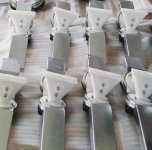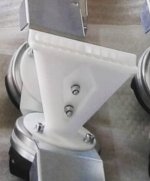I just came accross this software which can perform a dual channel FFT with m-noise: https://opensoundmeter.com/en/ free is much cheaper than SMAART!
You can also rent measurment mics from people like studiocare if you have a one off requirment.True, but with dynamic mics often struggling above 10kHz and below 50Hz (requiring large compensations and, in the HF, finnicky positioning), I'd opt for a large-diaphragm condenser. It's often possible to rent those from nearby studios, and the good ones will take >150dB without complaining.
Chris
They're mounted at the throat of the horn on a 3D-printed combiner, as you'd expect. The 2" elements tap in close to the throat via semi-circular slits. From that point, the horn itself is 'just' a segmented flare with asymmetrical expansion in the vertical dimension.how does this work for the 1" elements?
Some cropped screenshots of an old Instagram post:


I just came accross this software which can perform a dual channel FFT with m-noise: https://opensoundmeter.com/en/ free is much cheaper than SMAART!
You can also rent measurment mics from people like studiocare if you have a one off requirment.
As great as OSM is for free, the process is still very involved. Personally I don’t think a real-time FFT tool is appropriate. It relies far too much on a visual assessment of objective parameters.
You should be in the far field of the source, so mic clipping is less of a concern if you have a field or car park nearby and can average enough to minimise the impact of wind. The bigger problem is a large enough amplifier to supply sufficient unclipped peak voltage - this is covered in the AES specification document. You need >300V — a bridged pair of Powersoft X8 channels — to drive the midrange of many larger pro audio boxes to their Lpeak…
You seem to be handy with MATLAB, so why not make a script that actually assesses sequential traces and controls the gain increase steps properly?
Last edited:
ah ok I'm out of date having not read the AES document and just going from the procedure here using a dual channel FFT: https://m-noise.org/procedure/ . We do have a Lab Gruppen FP 10000Q that should do 300Vpeak bridged but I will need to get a higher SPL mic to test any 'serious' speakers. Automating in MATLAB/Octave would be pretty straightforward but at the moment I'm very overloaded with other projects....
Thanks for the additional photos I think I get it now
Thanks for the additional photos I think I get it now